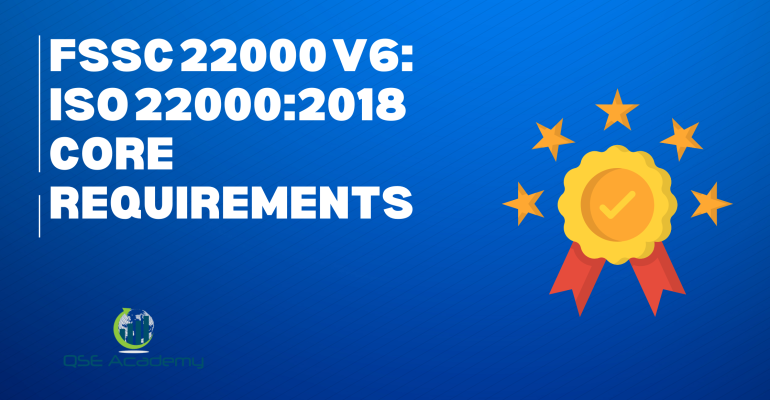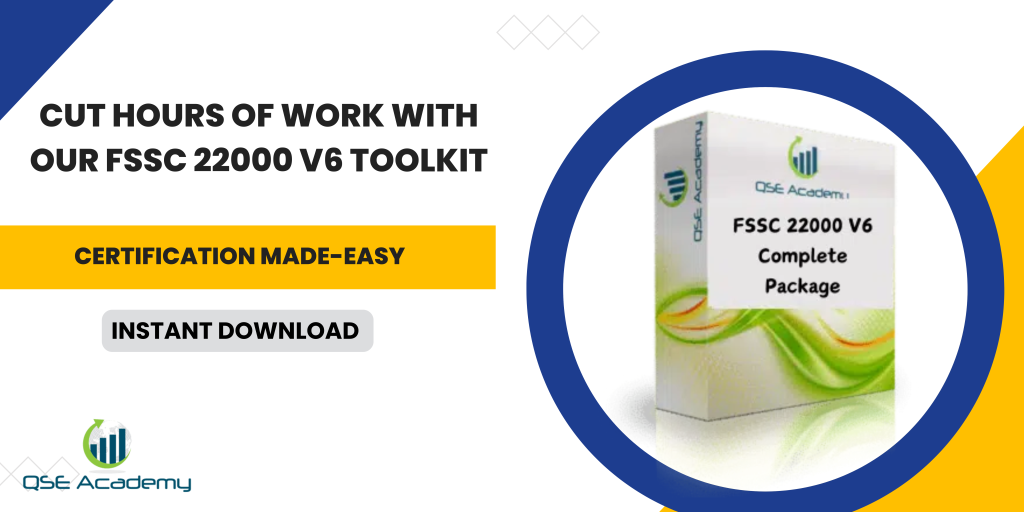FSSC 22000 V6: ISO 22000:2018 Core Requirements
Understanding ISO 22000 as the Foundation of FSSC 22000 V6
If you’ve ever tried to navigate the FSSC 22000 framework without understanding ISO 22000 first, you probably know how confusing it can get.
At QSE Academy, we’ve guided hundreds of companies—from family-owned bakeries to global packaging plants—through both ISO 22000 and FSSC 22000 certification. And what we’ve noticed is simple: businesses that master ISO 22000 early build stronger, audit-ready systems faster.
This guide breaks down the core ISO 22000:2018 requirements that sit at the heart of FSSC 22000 V6. By the end, you’ll see exactly how each clause connects to real-world food safety performance—and how to make your system both compliant and practical.
Context & Scope — Why ISO 22000:2018 Is the Backbone of FSSC 22000 V6
Here’s the truth: FSSC 22000 V6 doesn’t replace ISO 22000—it extends it.
Think of ISO 22000 as your management-system skeleton and FSSC 22000 V6 as the muscle that strengthens it with GFSI recognition and industry-specific details.
In practice, ISO 22000 defines the Plan-Do-Check-Act cycle and the risk-based thinking behind your Food Safety Management System (FSMS). FSSC 22000 V6 adds layers like Food Fraud, Food Defense, and Allergen Management.
Pro Tip: Always implement ISO 22000 clauses 4–10 first. They give your system its logical foundation before you add the FSSC specifics.
Common Mistake: Many teams jump straight to FSSC checklists and skip ISO 22000 documentation. That’s like trying to decorate a house before you’ve built the walls.
 Clause 4 — Context of the Organization & Interested Parties
Clause 4 — Context of the Organization & Interested Parties
Before you write a single procedure, step back and ask: What’s the world we’re operating in?
Clause 4 pushes you to identify internal and external factors that affect food safety—from supply-chain disruptions to new labeling laws.
One client—a dairy manufacturer—mapped its context and realized that changes in milk-transport temperature controls were their biggest external risk. That insight led to better contracts with haulers and zero spoilage incidents that year.
Pro Tip: Create a simple “Context & Interested Parties Matrix.” It keeps auditors happy and shows you’ve thought through every factor affecting your FSMS.
Avoid: Treating this as a one-time document. It should evolve as your business and risks change.
Clause 5 — Leadership & Commitment to Food Safety
Strong leadership can make or break your FSMS. Clause 5 expects top management to do more than sign a food safety policy—they must live it.
When leaders actively join management reviews or personally follow up on audit findings, auditors immediately sense commitment.
In one beverage-processing company we worked with, the CEO made food safety KPIs part of monthly performance meetings. Within months, incident rates dropped by 40%.
Pro Tip: Keep leadership visibly involved in communication, resource allocation, and decision-making.
Common Mistake: Assuming your QA Manager “owns” food safety. ISO 22000 expects shared accountability.
Clause 6 — Planning & Risk-Based Thinking
Risk-based thinking is the engine of ISO 22000. It’s not just about hazards in the kitchen—it’s about predicting anything that could disrupt safe food production.
Use risk analysis to connect your HACCP plan with broader strategic risks like supplier instability or equipment downtime.
A snack-food client once identified “powder cross-contamination” as a major risk. Instead of waiting for an incident, they redesigned air-flow zoning—saving thousands in potential recalls.
Pro Tip: Use a combined “HACCP + Risk Matrix” to keep everything visible in one place.
Common Mistake: Mixing up “risk” and “hazard.” Remember, hazards are food-safety specific; risks include management-system factors too.
Clause 7 — Support & Resources for FSMS Compliance
Even the best plan fails without the right support. Clause 7 focuses on resources—people, infrastructure, communication, and documentation.
Auditors often catch organizations with outdated training records or incomplete competence evaluations. A system is only as strong as the people running it.
One packaging firm we helped built a training tracker aligned with FSSC’s requirements on Food Fraud and Food Defense. That simple move turned their training program into measurable proof of competence.
Pro Tip: Keep competence matrices linked directly to job descriptions and training logs.
Pitfall: Relying solely on certificates; auditors also want evidence of practical application.
Clause 8 — Operation & Control of Food Safety Processes
This is where theory meets the factory floor. Clause 8 walks you through PRPs (Prerequisite Programs), Operational PRPs, and CCPs.
It’s about designing workflows that prevent contamination before it even becomes a threat.
A beverage producer we worked with aligned their cleaning validation with ISO/TS 22002-1 and slashed downtime by 15%.
Pro Tip: Map your PRPs directly to the relevant ISO/TS 22002 standard—it shows auditors precision and control.
Common Mistake: Over-documenting every small control as a CCP. Keep CCPs limited to steps that truly eliminate or reduce hazards to acceptable levels.
Clause 9 — Performance Evaluation & Continuous Improvement
You can’t improve what you don’t measure. Clause 9 ensures your FSMS stays alive through data.
Monitoring, analysis, and management reviews must drive real decisions—not just fill audit folders.
An internal audit should uncover trends, not just nonconformities. For example, one seafood company used audit results to spot repeated sanitation delays and introduced automated scheduling—reducing cleaning non-compliances to zero.
Pro Tip: Treat management reviews as business reviews. Discuss trends, performance, and opportunities—not just findings.
Mistake to avoid: Treating performance evaluation as an annual task instead of a continuous process.
Clause 10 — Improvement & Corrective Actions
Every system faces problems—what matters is how you respond.
Clause 10 emphasizes corrective action, root-cause analysis, and continual improvement.
A bakery chain once struggled with recurring allergen incidents. Once they performed a structured root-cause analysis, they discovered labeling confusion between production shifts. A quick visual control fix eliminated the issue entirely.
Pro Tip: Keep a CAPA Log linked to your risk register. It proves your system learns from experience.
Common Mistake: Closing corrective actions without verifying effectiveness—auditors will check.
Integrating ISO 22000:2018 Core Requirements into Your FSSC 22000 V6 FSMS
Now that you understand the core clauses, it’s time to connect them with FSSC’s additional modules.
Start by mapping ISO 22000 clauses 4–10 to FSSC Part 2 Additional Requirements such as Product Labeling, Food Defense, and Allergen Management.
Pro Tip: Run a Gap Analysis Audit before full implementation. It’s the fastest way to identify weak points before the certification body does.
When done right, integration turns your FSMS from a compliance tool into a competitive advantage.
FAQs — Clarifying ISO 22000 Core Requirements for FSSC 22000 V6
Q1: Do I need to implement all ISO 22000 clauses before FSSC 22000 V6 certification?
Yes. FSSC 22000 V6 builds directly on ISO 22000:2018. You can’t pass the audit unless your system demonstrates full compliance from clauses 4–10.
Q2: What’s the difference between PRPs and CCPs?
PRPs are your preventive basics—cleaning, pest control, hygiene.
CCPs are specific control points where failure could lead to unsafe food. Both are vital, but they serve different roles.
Q3: Can I reuse my ISO 9001 documentation?
Definitely. Procedures for document control, management reviews, and risk analysis can often be adapted to meet ISO 22000 requirements with minimal effort.
Conclusion — Master ISO 22000 to Build a Robust FSSC 22000 V6 System
ISO 22000 isn’t just paperwork—it’s the heartbeat of FSSC 22000 V6. When your team understands these clauses and applies them consistently, certification becomes the natural result of good management, not a stressful event.
At QSE Academy, we’ve spent years simplifying this process for food businesses around the world. Whether you need templates, training, or step-by-step implementation support, we’ve got the tools to make compliance practical and sustainable.
Download QSE Academy’s ISO 22000 Core Requirements Toolkit
or
Book a Free Consultation to review your FSSC 22000 V6 readiness.
Melissa Lavaro is a seasoned ISO consultant and an enthusiastic advocate for quality management standards. With a rich experience in conducting audits and providing consultancy services, Melissa specializes in helping organizations implement and adapt to ISO standards. Her passion for quality management is evident in her hands-on approach and deep understanding of the regulatory frameworks. Melissa’s expertise and energetic commitment make her a sought-after consultant, dedicated to elevating organizational compliance and performance through practical, insightful guidance.








